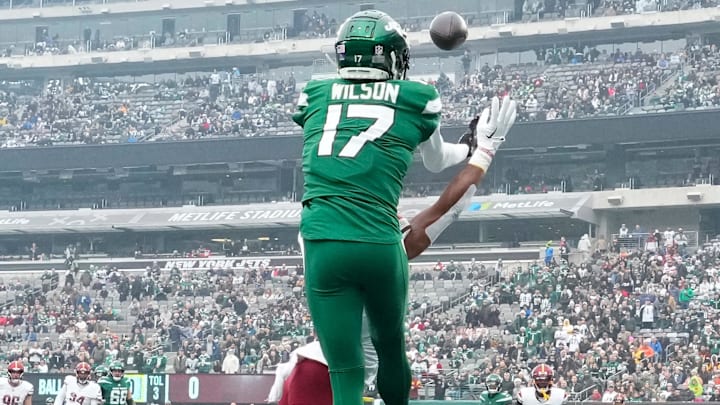Explosive playmakers. Physical freaks. Aerial acrobats. Blazing speedsters. Wide receivers can fit any of those descriptions and more. They can come in many different shapes and sizes. They can win in a variety of different ways. There's no one-size-fits-all all. What is a universal truth, however, is that these are some of the most exciting players on the field.
The AFC East has plenty of firepower — both proven and unproven — to tantalize fans and strike fear in the heart of opposing defenses. Continuing our series of ranking the NY Jets versus the rest of the AFC East position groups we arrive at the wide receivers. We've previously looked at the AFC East QB and running back rooms.
As a refresher, while star power matters, so too does depth. Perhaps even more so here where three and four wideout sets are common, and injuries are a fact of life. To that end, let's dig in ranking from worst to first.
4. New England Patriots
The depth chart: Kendrick Bourne, DeMario Douglas, Ja'Lynn Polk, JuJu Smith-Schuster, K.J. Osborn, and Javon Baker.
Over the last few seasons, the New England Patriots have fielded one of the weakest wide receiver groups in the league. This year is no exception, though there is some potential with rookies Ja'Lynn Polk (second round, pick 37) and Javon Baker (fourth round, pick 110) now in the fold.
New England hasn't had much luck with their receiver draft picks in recent years. 2019 first-round pick N'Keal Harry didn't even finish out his rookie contract with the team. 2022 second-round pick Tyquan Thornton has managed just 35 catches for 338 yards in two seasons, and is probably on the outside looking in for a roster spot in 2024.
On the flip side, 2023 sixth-round pick DeMario "Pop" Douglas was a bright spot, hauling in 49 passes for 561 yards, but no touchdowns. At 5-foot-8 and 192 pounds, he's a shifty slot receiver with good but not great speed. There's value here, but not enough to be the focal point of a passing attack.
The trio of Bourne, Osborn, and Smith-Schuster don't inspire much confidence either. The three are all capable third or fourth options on a good team, however, here they're all sliding a spot or two higher in the pecking order.
Bourne is the most well-regarded at this point, but he's coming off of a torn ACL that may limit him to start the season. Smith-Schuster looked like a budding star in a 2018 campaign that saw him catch 111 passes for 1,426 yards and seven touchdowns in his sophomore season with the Pittsburgh Steelers.
He'd never approach those heights again. Over the last four seasons, he's failed to record over 10 yards per reception in three of the four campaigns. 2023, his first year in New England, saw him limited by injuries and post the second-worst season of his career, with 29 catches, 260 yards, and one touchdown.
Osborn has been productive as a third or fourth option with at least 48 catches and at least 540 yards each of the last three seasons. That production, however, came with all-world receiver Justin Jefferson drawing most of the defense's attention in Minnesota.
Polk and Baker are the wild cards that could eventually confirm this ranking or vault New England higher up on the list. Polk doesn't have elite speed but has contested catch ability and deep ball-tracking skills.
Baker is similar both in size and speed, while also a good deep ball tracker. He doesn't always play through contact in contested catch scenarios like Polk. With both being rookies, the caveat of seeing them in real game action against NFL competition applies.
Overall, depending on how the rookies perform New England could vault up a spot or two, but for now, this is the weakest receiver room in the division.
